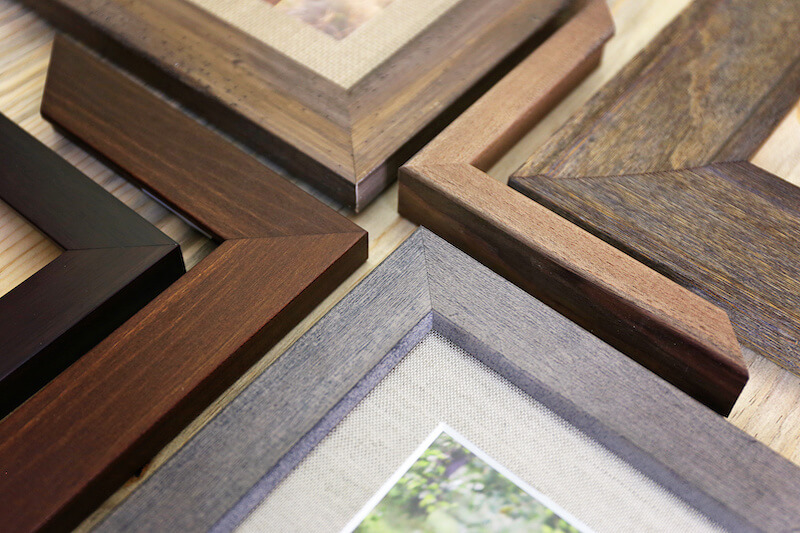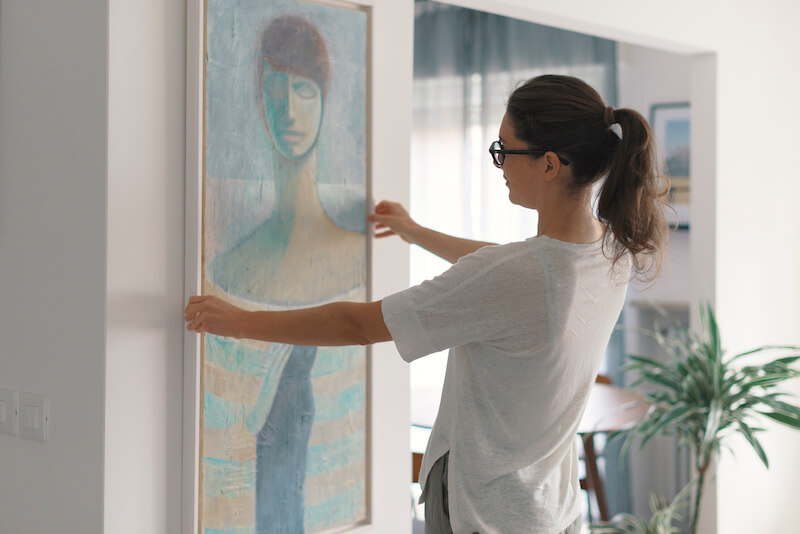Framing a canvas print isn’t required, but doing so adds protection and creates a polished look that suits some design strategies. While unframed canvas prints offer a minimalist vibe when hung as is, framed prints elevate the artwork by giving it a defined boundary. A frame can also safeguard the canvas edges from accidental damage, dirt, and wear. Here’s an easy step-by-step guide to help you frame canvas art.
4 Quick Tips For Framing Canvas Art
- Measure canvas dimensions accurately and ensure compatibility with the chosen frame size and style.
- Select a frame style and color that complements the artwork
- Rolled canvases will have to be stretched before framing.
- Attach the canvas to the frame using offset clips, ensuring a secure fit without damage.
Measuring the Canvas
Start by using a measuring tape to determine the height and width of your canvas art.
For a stretched canvas, it’s essential to measure from the outer edge of the stretcher bars, as this will dictate the dimensions needed for a good frame fit. For rolled canvases, measure the canvas before and after stretching, guaranteeing a snug fit in the frame.
Hook the tape measure at one edge of the canvas and extend it across to the opposite side. Record the measurements in inches or centimeters based on your frame’s specifications. Double-check these measurements by taking them in multiple spots to confirm accuracy— especially if your canvas is handmade and might have slight size variations.
Choosing the Right Frame

Floating and traditional frames are the two most common choices for canvas.
Floating frames create a small gap between the canvas and the frame, giving the artwork a “floating” effect. On the other hand, traditional frames add a classic, finished look to a canvas print by enclosing the edges, creating a polished boundary that enhances the artwork’s presence.
Don’t overlook the color and finish of the frame. Neutral tones can help your art stand out, while vibrant frames can complete a 60-30-10 color scheme. Although they’re not always necessary, consider matting options; they can add depth and professionalism to your display.
Choose a frame made from acid-free materials to protect your art. Also, consider the canvas’s thickness, as some frames are designed specifically for deeper or shallower canvases.
Preparing the Canvas
Prepare the canvas by gently removing dust or debris. A clean surface highlights the artwork’s true colors and prevents imperfections in the final presentation.
If the canvas has persistent smudges or dirt, lightly dampen the cloth with distilled water and gently wipe the affected areas, avoiding excessive moisture to prevent damage. Inspect the canvas edges for frayed threads or imperfections, and trim or smooth them as needed. Additionally, check the back of the canvas for any staples or excess material that might interfere with framing and secure or trim them accordingly.
Framing a Stretched Canvas
Stretched canvas prints are display-ready but can achieve a more refined and professional look with a floating or traditional frame.
To frame a stretched canvas, start by selecting a frame size that matches the dimensions of your artwork, ensuring there is enough space for the full image to show. Place the canvas into the frame and center it with even space on all sides.
Secure the canvas to the frame by attaching mounting brackets, clips, or screws to the back of the stretcher bars, being careful not to over-tighten, which could damage the canvas. Unlike other artwork, a stretched canvas does not require glass or matting, as its sturdy construction and surface texture provide durability and aesthetic appeal. Once secured, check the alignment and hang the framed piece in your chosen location.
Framing a Rolled Canvas
A rolled canvas, often purchased or shipped this way, is an economical and space-saving option for artists and collectors. However, you’ll need to stretch it before framing. If your artwork started as a rolled canvas, allow it to relax for 24-48 hours to avoid any warping once framed.
Stretching a rolled canvas requires patience and a few basic tools.
Materials Needed:
- Rolled canvas
- Wooden stretcher bars (pre-cut or adjustable)
- Staple gun with staples
- Canvas pliers (optional but helpful for a firm grip)
- Scissors
- Hammer (to secure stretcher bar corners)
- Flat surface or workbench
Begin by assembling and squaring the stretcher bars, ensuring they are even and secure. Lay the unrolled canvas face down on a flat surface and position the stretcher bars on top, leaving equal margins on all sides.
Secure one side by folding the canvas over the bar and stapling at the center, then stretch and staple the opposite side, pulling the canvas tight with pliers to maintain even tension.
Repeat for the remaining sides, working outward from the center and stapling every 2–3 inches. Neatly fold and staple the corners, trim excess canvas from the back, and check for tightness, making adjustments if necessary.
Once stretched, you can follow the same framing techniques as you would for a pre-stretched canvas. Alternatively, you can frame a rolled canvas without stretching by sandwiching it between a backing board and a frame with glass. This method provides maximum protection against dust and damage, although it alters a stretched canvas’s traditional appearance.
Hanging Your Framed Art

To hang your canvas, mark a spot about 58-60 inches above the finished floor. When hanging multiple pieces as a gallery wall, maintain a center point at the same height with a two-inch spacing between each frame.
Use a level tool to keep each piece straight, preventing any visual misalignment that can detract from the artwork’s appeal. The bottom of the frame should be 8 to 10 inches above any furniture it’s displayed over, guaranteeing a cohesive appearance that doesn’t feel cramped.
Selecting the right hanging hardware is essential. Sawtooth brackets work well for lighter pieces, while heavier frames require more robust options like J hooks. When using a hanging wire, make sure it’s securely fastened to prevent accidents.
Elevate Your Canvas Prints With the Right Frame
Framing canvas art is almost an art itself, but with these helpful tips, you can hang your art like a professional and enjoy it to its fullest potential. Whether you’re picking out the perfect frame, or preparing your canvas, these tips will turn your boring wall space into an exhibit at an art museum. Pick out your frame online or at your local art store, and start framing your canvas art like a pro.




